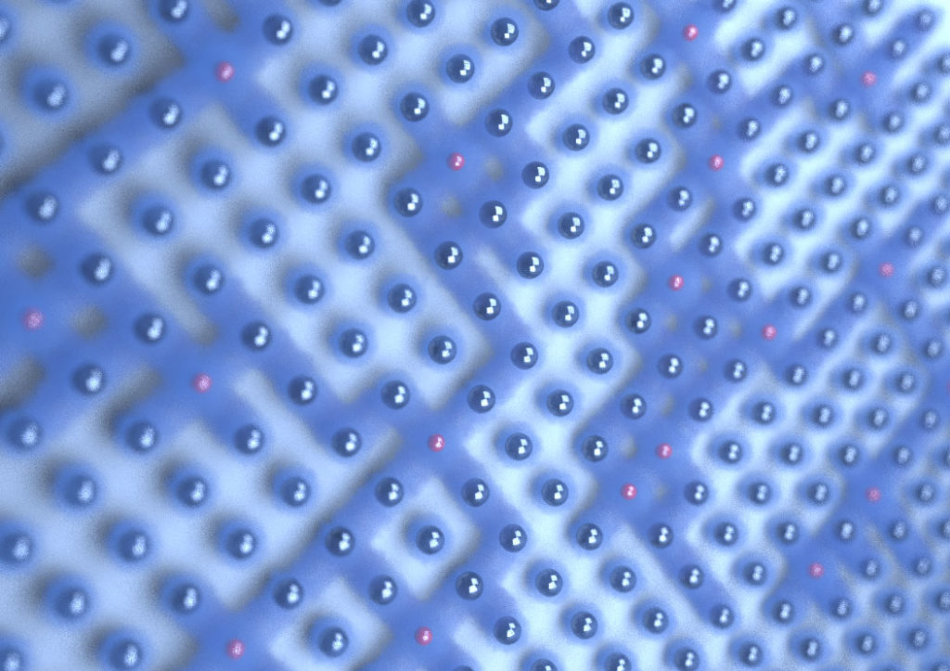Feb 4 2020
A majority of the new-age electronic devices are dependent on small, finely adjusted electrical currents for processing and storage of information. These currents govern regular ticking of pacemakers, the speed at which computers work, and the security of the money stored in the bank.
 Artist’s impression of the dissolving of the electronic “traffic jam.” The red atoms are different in their quantum nature and allow the transport of electrons in their surroundings. Image Credit: SBQMI
Artist’s impression of the dissolving of the electronic “traffic jam.” The red atoms are different in their quantum nature and allow the transport of electrons in their surroundings. Image Credit: SBQMI
Scientists at the University of British Columbia have developed and demonstrated a completely new technique for accurately controlling such electrical currents by making use of the interaction between the spin of an electron (the quantum magnetic field intrinsically carried by an electron) and its orbital rotation around the nucleus. The study was reported in the Nature Physics journal.
We have found a new way to switch the electrical conduction in materials from on to off. Not only does this exciting result extend our understanding of how electrical conduction works, it will help us further explore known properties such as conductivity, magnetism and superconductivity, and discover new ones that could be important for quantum computing, data storage and energy applications.
Berend Zwartsenberg, Study Lead Author and PhD Student, Stewart Blusson Quantum Matter Institute, The University of British Columbia
Flipping the Switch on Metal-Insulator Transitions
All materials can be widely classified as metals or insulators, based on the ability of electrons to conduct electricity by moving through the material.
But not all insulators are equally formed. In the case of simple materials, the difference between insulating and metallic behavior arises from the number of electrons that exist: an even number for insulators, and an odd number for metals. In the case of highly complex materials, such as the so-called Mott insulators, the electrons interact with each other in various ways and their electrical conduction is governed by a subtle balance.
Electrostatic repulsion in a Mott insulator stops the electrons from becoming too close to each other, thereby forming a traffic jam and restricting the free flow of electrons. To date, there was a dearth in techniques to free up the traffic jam. The two known ways were: by varying the number of electrons, or by decreasing the strength of repulsive interaction between the electrons.
The SBQMI researchers investigated a third possibility: is it feasible to change the material’s very quantum nature to allow a metal-insulator transition to take place?
The researchers used a method known as angle-resolved photoemission spectroscopy to investigate the Mott insulator Sr2IrO4, where the number of electrons, the electrostatic repulsion between the electrons, and finally, the interaction between the electron spin and its orbital rotation were monitored.
We found that coupling the spin to the orbital angular momentum slows the electrons down to such an extent that they become sensitive to one another’s presence, solidifying the traffic jam. Reducing spin-orbit coupling in turn eases the traffic jam and we were able to demonstrate a transition from an insulator to a metal for the first time using this strategy.
Berend Zwartsenberg, Study Lead Author and PhD Student, Stewart Blusson Quantum Matter Institute, The University of British Columbia
“This is a really exciting result at the fundamental physics level, and expands the potential of modern electronics,” stated Andrea Damascelli, co-author of the study, who is the principal investigator and scientific director of SBQMI.
If we can develop a microscopic understanding of these phases of quantum matter and their emergent electronic phenomena, we can exploit them by engineering quantum materials atom-by-atom for new electronic, magnetic and sensing applications.
Andrea Damascelli, Study Co-Author, Principal Investigator and Scientific Director, Stewart Blusson Quantum Matter Institute